If I have just a battery, the terminals are separated by air, a very good insulator. We can say, practically, that no current flows.
However, air has a very large, but finite resistivity. Wikipedia gives a range of \$1.3\cdot 10^{16}\$ to \$3.3\cdot 10^{16} \Omega \mathrm m\$, which I'm sure varies by pressure, temperature, humidity, pollutants, and so on.
From that, can we calculate the resistance between the battery terminals, knowing the dimensions of the battery, and assuming that there is an infinite space of air around the battery? What's the math?
Could this be extended for calculating the resistance between two points in an arbitrary material, of infinite volume, with a known resistivity? The practicality of obtaining an infinite volume of a thing aside, I'm wondering how resistivity relates mathematically to idealized volumes of things that aren't extruded blocks of things. (That is, not \$R = \rho L / A\$.)
